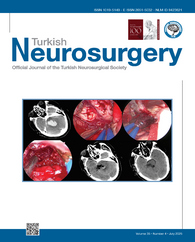2National Institute of Mental Health and Neurosciences, Department of Neuroimaging and Interventional Radiology, Bengaluru, Karnataka, India
3Paras Hospital, Department of Neurointervention, Delhi, India
4National Institute of Mental Health and Neurosciences, Department of Neurosurgery, Bengaluru, Karnataka, India
5National Institute of Mental Health and Neurosciences, Department of Biostatistics, Bengaluru, Karnataka, India
6National Institute of Mental Health and Neurosciences, Department of Neuroanaesthesia, Bengaluru, Karnataka, India DOI : 10.5137/1019-5149.JTN.46902-24.2 AIM: To perform comparison of preoperative and postoperative mean transit time (MTT) delay in ipsilateral, and contralateral hemispheres in Moyamoya disease using dynamic susceptibility contrast (DSC) perfusion.
MATERIAL and METHODS: Preoperative images were obtained within 1 week before surgery and postoperative images were taken 3 months after surgery. Cerebral perfusion was assessed in bilateral middle cerebral artery territories with 3 Region Of Interest (ROI) on each side (ipsilateral and contralateral to surgery side). Two ROI were also drawn in bilateral cerebellar hemisphere. MTT delay at each middle cerebral artery (MCA) region was calculated by subtracting MCA territory ROI MTT value from ipsilateral cerebellar ROI MTT value. Non-normally distributed measurement data are expressed as the median [interquartile range (IQR)] and compared using Wilcoxon?s rank-sum test. p<0.05 was considered statistically significant.
RESULTS: Median ipsilateral MTT delay values (in seconds) before surgery were 2.4, Interquartile Range (IQR) 4.95; and after surgery was 1, IQR 2.1 We noted a significant decrease in postoperative MTT delay values on ipsilateral side compared with preoperative values (p=0.008). Contralateral MTT delay values did not show this trend. Median contralateral MTT delay values (in seconds) before surgery were 0.6, IQR 3.7; and after surgery was 1.6, IQR 3.65 We noted no significant difference in preoperative and postoperative MTT delay values on contralateral side (p=0.12).
CONCLUSION: DSC perfusion analysis of MTT delay in follow up imaging after revascularization surgery can be helpful in deciding success of surgery. Evaluation of contralateral hemisphere perfusion can be helpful to guide regarding need of contralateral side surgery. Future studies to evaluate contralateral perfusion characteristics are necessary to understand the complex hemodynamic changes which occur post revascularization surgery.
Keywords : Moyamoya disease, Perfusion, MTT delay, Revascularization surgery, DSC perfusion




